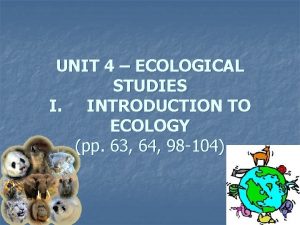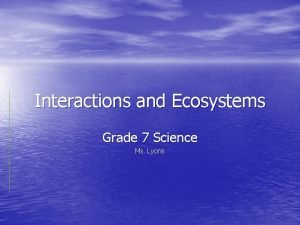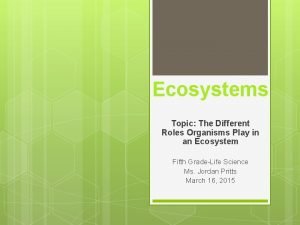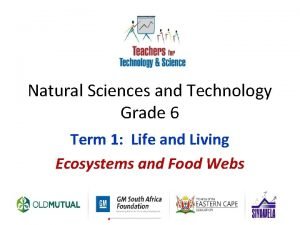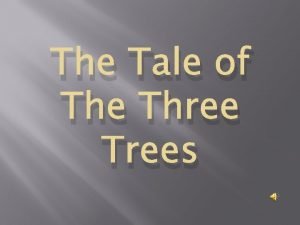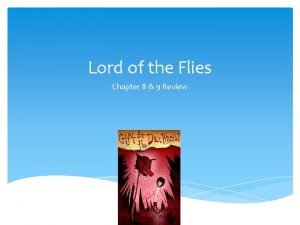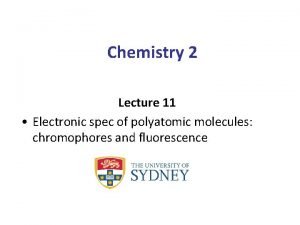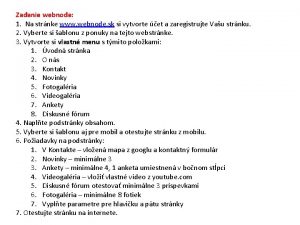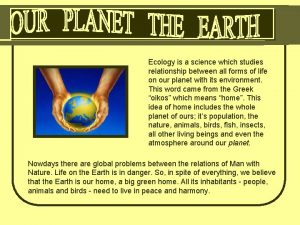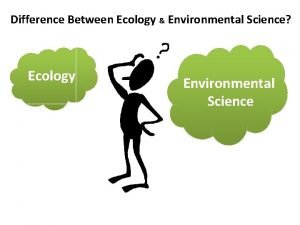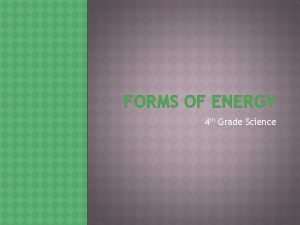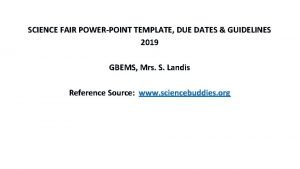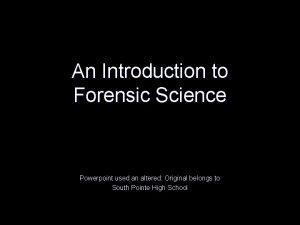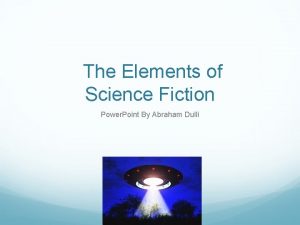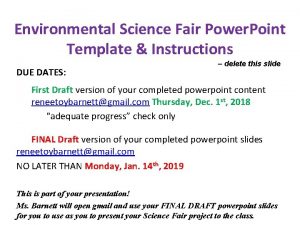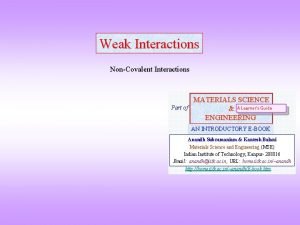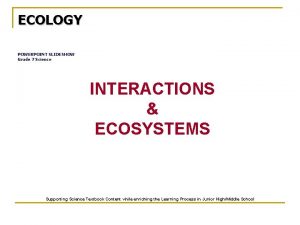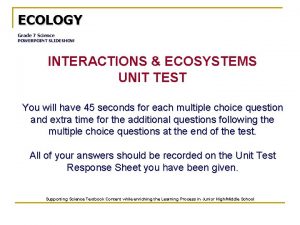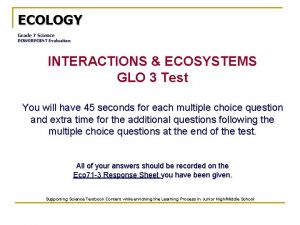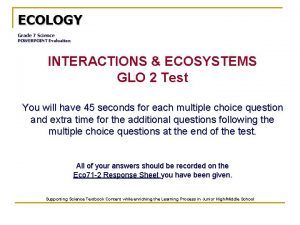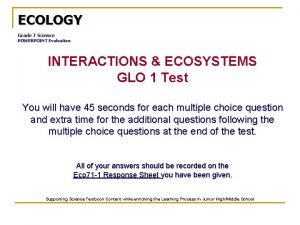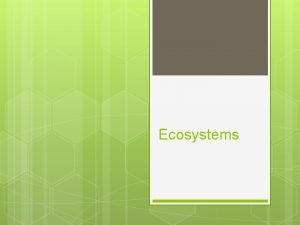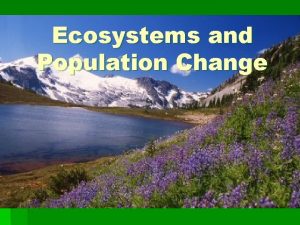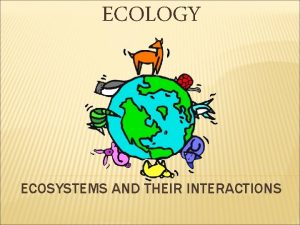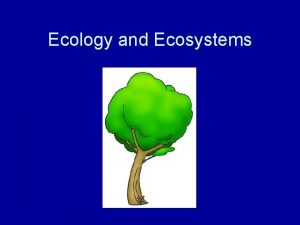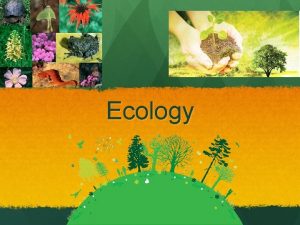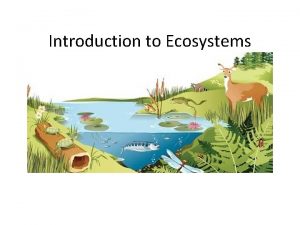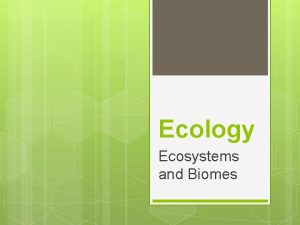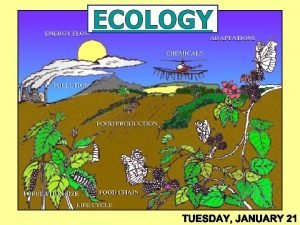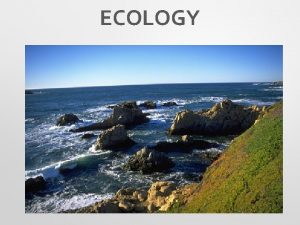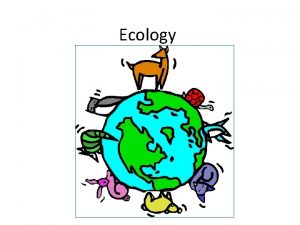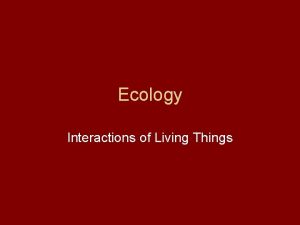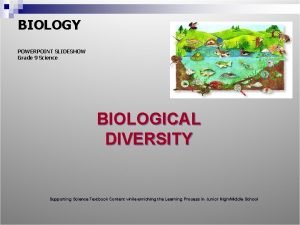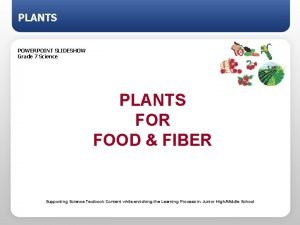ECOLOGY POWERPOINT SLIDESHOW Grade 7 Science INTERACTIONS ECOSYSTEMS






































- Slides: 38

ECOLOGY POWERPOINT SLIDESHOW Grade 7 Science INTERACTIONS & ECOSYSTEMS Supporting Science Textbook Content while enriching the Learning Process in Junior High/Middle School

ECOLOGY Concept Map Shows the concepts covered within the framework of this unit Ecology – Grade 7

ECOLOGY Outline of Key Concepts Slides Key Concepts 4 Ecosystem 27 - 29 Monitoring Change 5 Characteristics of Living Things 6 Niches 31 - 32 Ecological Footprint Relationships 33 - 34 Pollution 7 -8 30 Sustainability 9 Biomass 35 Adaptation 10 Life Processes 36 Controlling Species 11 - 12 Decomposers & Scavengers 37 Saving – Recovering Species 13 - 14 Symbiosis 15 - 16 Cycles 17 - 24 Human Impacts on Ecosystems 25 Change In Ecosystems 26 Succession

ECOLOGY - Ecosystem Ecology is the study of the relationship between living organisms and their environment. An ecologist is someone who studies those relationships. An ecosystem is a place, such as a rotting log, a forest, or even a schoolyard, where interactions between living and non-living things occur. All living organisms and nonliving parts within this place are interacting all the time and adjustments must occur if the organisms are to survive. Living organisms make up the biotic components of the ecosystem, while non-living things make up the abiotic parts of the same ecosystem. Ecosystems vary in size and complexity. In order to study an entire ecosystem, ecologists often study only a small aspect of an ecosystem and then work with other ecologists to piece together the overall picture of how the ecosystem functions.

Definition of Alive… n n n Has never been universally agreed upon. 1. reproduction 2. growth and/or differentiation through metabolism (which usually implies some form of respiration) 3. adaptation to the environment 4. the ability to distort entropy--that is, to increase or maintain the organization of the living system at the expense of the environment.

ECOLOGY - Basic Characteristics of Living Things Species within an ecosystem refers to those living things that can reproduce and have young that can also reproduce. When there a number of individuals of the same species within an ecosystem the group is called a population All the populations of the many different species that live and interact together in the same ecosystem is referred to as community Living things need food. Living things need a suitable habitat. Living things need water. Living things exchange gases.

ECOLOGY - Niches All of the organisms within an ecosystem have different roles. These roles are called niches Organisms can have more than one niche and knowing the niches of an organism can help to explain why they act and interact the way they do. To determine an organism's niche, you need to identify what it eats, where it lives and how it interacts with the other organisms in the same ecosystem. Niches include: Producers - produce food energy for themselves and others Consumers - consume the food made by the producers Herbivores - eat producers (plant eating niche) Carnivores - eat other consumers (meat eating niche) Predators - eat Prey Omnivores - eat both producers and consumers

ECOLOGY - Relationships - Food Chain A food chain is a model that shows how energy stored in food passes from organism to organism. Energy flow is the movement of energy, starting with the sun, and passing from one organism to another. As energy flows from one organism to another a food chain is established. Food chains usually involve more than three organisms.

ECOLOGY - Relationships - Food Web - Food Pyramid A food web is a combination of many different food chains, showing the interrelationships between and among many different producers and consumers in an ecosystem. A Food Pyramid is a model, which represents the number of organisms consumed at each successive level of the pyramid. The size of each level indicates the number of organisms at that level. There always more animals being eaten than are eating.

ECOLOGY - Biomass To find out how much energy is being transferred from one level of the pyramid to the other, Biomass needs to be calculated. Biomass is the total of all the organisms in the ecosystem. As you move up the pyramid, there is less biomass. The most biomass is found at the base, where the producers are. Ecosystems get energy originally from the Sun through the process of photosynthesis Light energy is used by plants to make food, which contains the chemical energy that plants use for their life functions. 90% of this energy is used by the plant and the remaining 10% is available to the herbivore that eats the plant. The herbivore uses 90% of this energy to maintain life functions and provides the remaining 10% to the carnivore. Most of the energy is used to maintain body heat, which escapes into the environment and cannot be used. The flow of energy is one way. Producers Herbivore Carnivore ‘Waste Energy’ – body heat escaping into the environment

ECOLOGY - Life Processes Photosynthesis The raw materials needed by plants to produce their own food -with the energy from the Sun - are water and carbon dioxide. The products produced are food (sugars) and oxygen, which is released back into the atmosphere. The food making process is called photosynthesis. Light Energy + Carbon Dioxide + Water Food (Sugars and Starches) + Oxygen This is important for 2 reasons: the sun’s energy can be converted into a for you can use and oxygen is made available for you to breathe. Oxygen - Plants need oxygen as well. All living things are able to release the energy that is stored in food through the process of cellular respiration. Food (Sugars & Starches) + Oxygen Carbon Dioxide + Water + Energy (used by living things) A Vital Interaction The products of one chemical reaction (photosynthesis) are used by the other chemical reaction (cellular respiration)

ECOLOGY - Decomposers and Scavengers The Clean-Up Squads Decomposers are different from scavengers because they do not actually eat dead material. They grow on or in the dead or waste matter, absorbing the nutrients directly into their cells, which are then recycled back into the environment. Bacteria Fungi Scavengers are organisms that feed on dead or decaying plant or animal matter. Wolverine Magpie

ECOLOGY - Decomposers and Scavengers Helpful Harmful Baker’s yeast- produce a by-product that makes dough rise. Candida albicans -cause a disease called thrush E coli (found in your large intestine) break down nutrients in food to make vitamins you need to stay healthy E Coli bacteria 0157 -H 7 produce toxic chemicals that result in food poisoning Nitrogen-fixing nodules home to bacteria which make nitrogen available to the plant Decomposers Are Essential To All Ecosystems Their actions make them the ‘clean-up crew’ and mean that plants will always have the nutrients they need to maintain life. They are the bridge between the biotic and abiotic parts of an ecosystem.

ECOLOGY - Symbiosis Symbiotic Relationships When two species live closely together in a relationship that lasts over time symbiosis occurs. There are three forms of symbiosis: Mutualism - occurs when there is a relationship between two different organisms, in which each partner benefits from the relationship. Examples include: Mutualism between plants and their herbivore 3 -way Mutualism between an ant, a butterfly caterpillar, sand an acacia plant Parasitism - occurs when there is a relationship between two different organisms, in which one partner benefits from the relationship, while the other parner is harmed. Typically, the partner that benefits (the parasite), lives on or in the other organism (the host), and feeds on it. Examples include: Aphid mummy - the result of parasitism A Kalahari barking gecko is crucified by a Shrik. Stored as a cache for a later meal.

ECOLOGY - Symbiosis Commensalism - occurs when there is a relationship between two different organisms, in which one partner benefits from the relationship, while the other neither benefits, nor is harmed. Examples include: Anemonefishes dwell among the tentacles of Tropical Sea Anemones Insects and Flowers Both partners apparently benefit from the relationship, Symbiotic relationships are only a few ways that organisms interact with one another within an ecosystem. Other interactions may involve the physical changing of the ecosystem by the organisms living in it and interacting with parts of it. Like when a family of beavers makes a dam, the stream below the dam dries up, killing the water organisms that need the water to survive. Above the dam, a pond changes the habitat and limits the kinds of organisms that can survive there. For every action in an ecosystem there is a resulting effect and reaction, which will change the make-up of the ecosystem in some way.

ECOLOGY - Cycles When organisms breathe, the gases are recycled in the air and used by other organisms. When organisms die, the nutrients they are composed of are recycled back into the environment and used as well. The Carbon Cycle Carbon is necessary for all life to exist and is recycled in the environment.

ECOLOGY - Cycles The Water Cycle All living things require water to survive and this water is also recycled over and over again. The water cycle (as illustrated) contains 4 processes: evaporation and transpiration – move water from the Earth to the atmosphere, condensation and precipitation return the water to Earth.

ECOLOGY - Human Impacts on Ecosystems Natural Resources are the materials and products that are found in nature, that people use to meet their basic needs The impact that people have on the use of resources can be very small, or can be huge, and can lead to positive or negative consequences. The needs of all living things now have to be met with the available natural resources. How we are able to satisfy these needs with minimal conflict will determine how resourceful we can be. Setting a forest on fire (a controlled burn) burn is often necessary to maintain a balance in the ecosystem. These fires get rid of small trees, leaves, needles and other debris that settles on the forest floor. The new growth after a fire becomes food for elk, deer and other animals that need these nutrients from the forest floor. When a family of beavers makes a dam, the stream below the dam dries up, killing the water organisms that need the water to survive. Above the dam, a pond changes the habitat and limits the kinds of organisms that can survive there. For every action in an ecosystem there is a resulting effect and reaction which will change the make-up of the ecosystem in some way. The decline in the beaver population in Yoho National Park has been as a result of improved firefighting equipment and fire-monitoring techniques Young Aspen trees (the beavers preferred source of food and shelter) are scarce and the other trees in the forest are growing too large for the beavers to use effectively.

ECOLOGY - Human Impacts on Ecosystems DDT (Dichloro-Diphenyl-Trichloroethane) is one of the best known pesticides. During World War II, DDT was used to combat mosquitoes spreading malaria, typhus, and other insect-borne diseases among both military and civilian populations. The Swiss chemist Paul Hermann Müller was awarded the Nobel Prize in Physiology or Medicine in 1948 "for his discovery of the high efficiency of DDT as a contact poison against several arthropods. “ After the war, DDT was made available for use as an agricultural insecticide, and soon its production and use skyrocketed. In 1962, Silent Spring by American biologist Rachel Carson catalogued the environmental impacts of the indiscriminate spraying of DDT and questioned the logic of releasing large amounts of chemicals into the environment without fully understanding their effects on ecology or human health. The book suggested that DDT and other pesticides may cause cancer and that their agricultural use was a threat to wildlife, particularly birds. Knowing what effects you are having on the environment (or will likely have) will help you make decisions.

ECOLOGY - Human Impacts on Ecosystems Sometimes the intention you had to begin with, does not result in what you want, or expect. It often ends up making things worse. (hence, Worse Case Scenario) Scenario Example: Mosquito populations in Borneo were causing malaria among the Dyak people. The World Health Organization used the pesticide DDT to kill off the mosquito population. However the DDT also killed a species of parasitic wasp that ate a certain species of caterpillar. This species of caterpillar began eating the material roofs of houses were made of and the roofs began falling on people’s heads. DDT also affected small bugs that were food for the geckos. The geckos began to move slowly and the cats, which normally ate rats, switched to the slower moving geckos. The cats eventually died of the DDT magnified in their food supply and the rat population increased. The rats were infested with fleas that carried a bacteria causing typhus malaria – a much worse form of the original malaria.

ECOLOGY - Human Impacts on Ecosystems The use of DDT (a chemical pesticide) was found to have a negative effect on Peregrine Falcons. It wasn’t until the species was almost lost completely that something was done. DDT was banned worldwide and recovery programs were put in place to restore the numbers of peregrine falcons Silent Spring became one of the signature events in the birth of the environmental movement. The ban on DDT is also cited by scientists as a major factor in the comeback of the bald eagle in the United States. Swift foxes were accidentally poisoned because certain predators were Natural control upset, the anticipated. seen as ‘pests’ or ‘unnecessary’ animals. When the Swift foxes used the poison instead, the species almost became extinct. is necessary in any ecosystem. If this natural control is impact can have ripple effects, which were never

ECOLOGY - Human Impacts on Ecosystems Needs are basic to survival, whereas, wants are things that just make survival more comfortable or enjoyable. Each time a need or a want is satisfied, natural resources or energy are used up. This impacts the environment we live in. Transporting food from all around the world, just so we can have the luxury of choice impacts other regions as well, because those regions had to clear land, use fuel (energy) and through the industrial processes caused pollutants to enter the air. When our want demands conflict with the health of our ecosystems, we need to begin making some more responsible choices. The needs of wildlife can be negatively impacted by the wants of people. When this happens we need to decide whether our want is more important than their need. The ways people interact with the environment has changed over time. Machines and advanced technologies have caused a higher impact than in the past. All of the needs people had in the past were satisfied by the natural resources they were able to find in the environment around them. Nowadays, resources are transported throughout the world, as the demand gets higher. Lifestyle changes over time have increased the pressure on different environments and the ecosystems we live in.

ECOLOGY - Human Impacts on Ecosystems Head-Smashed-In Buffalo Jump Buffalo were hunted by driving them to run off a cliff. The carcasses were then dragged to camps where they were processed into meat, hides, tools, and other necessary items. All parts of the buffalo were used, with minimal impact on the environment. Prairie Settlers Cattle Feedlots Early settlers kept mixed farms (livestock and crops). The improvements in technology allowed them to stay in one place (instead of following the food supply around). This lifestyle had a larger impact on the environment because farmland ranchland had to be modified, to support the crops and livestock. A large area that has been fenced in to feed cattle for food is called a feedlot. Once the beef is slaughtered and processed, the products are transported all over the world. The impact of this activity is significant, because cattle waste can pollute the water system nearby, and the soil conditions can be negatively affected.

ECOLOGY - Human Impacts on Ecosystems The production of wastes on our planet is increasing. The storage or disposal of these wastes - until they can be returned naturally back to the environment is a major problem. Waste disposal techniques include recycling, composting, incinerating, and hazardous waste operations. Sanitary landfills are similar to landfills, where waste is spread over a large area and then covered with soil to encourage the natural decomposition of the waste. To prevent and control leaking of hazardous products from the sanitary landfills, a clay liner and a system of drainage pipes is put into place.

ECOLOGY - Human Impacts on Ecosystems Many species in North America and in Canada specifically are in danger of extinction If a species becomes extinct, it can no longer be found anywhere in the world. Sometimes the organism is only lost in a large region. If this occurs, the species is extirpated If a particular species is in danger of becoming extinct, or extirpated, it is placed on the endangered species list The classification of species whose numbers are declining is threatened There are special protection programs and laws made to protect endangered species. Canada’s Endangered Species Alberta’s Endangered Species Famous Potatoes - The small town of Pemberton, British Columbia is home to world- famous potatoes. These potatoes are virtually free of virus and disease because only locally cultured and laboratory-inspected seeds are used to grow them.

ECOLOGY - Change in Ecosystems Competition - All living things compete for food, water and habitat. Because there is only so much to go around many species cannot survive because they are fewer in numbers and have more predators that other species. House sparrows European Starlings Examples of birds that have multiplied very quickly and compete for food with many native birds. Predation - Predation occurs when one animal hunts other animals for food. The organisms that are hunted are called prey The hunters are called predators The predator and prey populations increase and decrease as their numbers change. When prey population increases, the predator population will also increase. When the prey population decreases, the predator population also decreases. Weather - Weather can also affect ecosystems. Temperature, and he amount of precipitation will affect the growth of plants (the producers) positively or negatively. Natural disasters can also impact the populations of producers.

ECOLOGY – Succession The gradual process by which some species within an ecosystem replaces other species is called succession. Primary succession is the gradual growth of organisms in an area that was previously bare – like a rocky slope. Organisms to first appear are those that can cling to the rock and grow, such as mosses and lichens. These organisms break down the rock and died. Other organisms use the nutrients to begin to grow. Before After Examples of areas in which a community has never lived before would be a new lava or rock from a volcano that makes a new island or a new landscape, or sand bar that arises from shifting sands in the ocean, from exposure of igneous rock surfaces by a land slide, or if a meteor makes a depression that fills with rainwater or fresh water from underground streams. Secondary Succession The gradual growth of organisms in an area after a disturbance, such as a fire, or when a large tree falls, is known as secondary succession.

ECOLOGY – Monitoring Change Ecosystem monitoring (also called - environmental monitoring) is a way to check the condition - health - of an ecosystem by comparing results of investigations done at different times. Monitoring helps scientists understand impacts of disturbances and changes - sudden and gradual - in order to try to reverse or reduce the impact. Biotic and abiotic factors are monitored. Ecosystem Monitoring Types Physical, Physical uses satellites to track changes in the landscape over time. Environmental tracks changes in climate, temperature and weather patterns. Chemical, Chemical assesses the quality of air, soil and water Biological, Biological tracks the changes in organisms or populations of organisms

ECOLOGY – Monitoring Change Environmental monitoring usually begins after a disturbance has taken place. It can also begin before a disturbance occurs. A key part of the monitoring program is to provide the evidence on which environmental decisions can be made to maintain the balance between human needs and the needs of other organisms in the environment. Continuous monitoring gives us the scientific data we need to make informed decisions about how we affect the environment over time. Long-Term Monitoring Amphibians are very sensitive to environmental change, which makes them an indicator species. By using this indicator species, species scientists all over the word can study the effects of pesticides, acid rain, loss of habitat and introduction of non-native species on these amphibians. Using Science in Real Ecosystems The North River Basins Study (1991) was designed to see what impact the development of natural resources would have on the ecosystems in the region. The analysis of the results indicated that industries were having a negative impact.

ECOLOGY – Monitoring Change Monitoring programs may be qualitative, semi-quantitative or quantitative Monitoring involves the use of indicators, indicator species or indicator communities The presence or absence of the indicator or of an indicator species or indicator community reflects environmental conditions. Dichotomous Key (Identification Key for Alberta Amphibians) Amphibians Baseline Data gives scientists a starting point to compare changes in the environment. Scientists to monitor change use permanent plots, or study areas. The report that provides the data that has been collected - identifying how a certain activity will affect the environment - is called an Environmental Impact Assessment Quadrant Sampling is a technique used to study a large are. The quadrant is selected and the species is counted in the quadrant. The number of quadrants in the area provides the multiplier to estimate the Quadrant sampling is one way that ecologists estimate the distribution of different populations of species in an ecosystem. Studying the sample is called quadrant analysis

ECOLOGY - Sustainability We depend on the environment and we are part of the environment. Sustainability means that the resources from the environment can be replaced as quickly as they are used. Are we putting back what we take out, or, are we using up all the resources before they can be replaced? Sustainability Large Ecological Footprint

ECOLOGY – Ecological Footprint To calculate your ecological footprint, you need to determine the total area of land that you use and water needed to supply all of the energy and materials that you use, as well as absorb all of the waste that you produce. Materials that are included are: food, water, supplies to build shelter and raw materials needed to produce the manufactured products you use. Energy includes: electricity, natural gas, as well as all the energy needed to produce, and transport all of the manufactured products you use. The ecological footprint of average Canadians is very large, because they are using many more resources and creating much more waste than is sustainable. Ways to reduce ecological footprint include: Be aware of the products you consume in a typical day Reduce the energy you use Reduce the number of products you buy Reduce the amount of garbage you produce

ECOLOGY – Ecological Footprint REDUCE - REUSE - RECYCLE Better understanding the principle of sustainability will enable people to realize the impact their wants and needs have on the life of this fragile planet. The more knowledge we have about how our actions positively or negatively affect sustainability, the more often we will make choices that will sustain our natural resources.

ECOLOGY – Pollution in the Environment Pollution occurs when a substance is added to the environment at such a fast rate that it cannot be broken down, stored or recycled in the air, land, or water in a nondamaging form. Pollutants are substances that cause pollution. Type of Pollutant Acid Rain (high p. H level) - Sulfur and Nitrogen at higher than normal levels in the air, which mix with water to produce acidic precipitation. Carbon Dioxide - Burning of fossil fuels puts higher than normal levels of CO 2 into the atmosphere and the ozone layer (which protects us from radiation) is being depleted.

ECOLOGY – Pollution moves throughout the Environment Accidental contamination of the air, water or soil - or, unsafe use can cause pollutants to be a problem anywhere on the earth. Wherever there are pollutants, organisms can ingest them and eventually it gets into us. Bioaccumulation is the process in which a substance builds up in a living organism from the surrounding air or water, or through the consumption of organisms that already have the substance that is being accumulated. It will vary for different species and will depend on sources of contamination, as well as water quality and temperature. It provides increasing levels harmful to species higher up the food chain, because of "biomagnification ", where substances like mercury will increase In concentration from microorganisms, to fish eating predators like otters and loons, and to humans. The accumulated mercury is shown by the red dots. . Source: Communication Canada

ECOLOGY – Adaptation Humans affect the environments around them in many ways, including activities and technologies such as: forestry, industrial processes, transportation, urban development, construction and farming. When an ecosystem is changed by human activity, there can be unexpected consequences. Some species thrive when change occurs (eg. Cowbirds), while some species suffer (eg. Warblers ). Some Species Adapt Better Than Others The cowbirds adapt to farmland easily, while others cannot. The coyote has been able to adapt to the spread of urban areas, whereas other animals, such as the wolf have not.

ECOLOGY – Controlling Species Pest Control - Pests that can affect human health and crops are a major problem. Besides controlling the pest population a pesticide can also damage other organisms that are not targeted. This occurs with a pesticide that is designed to kill lygus bugs (who damage canola crops), also kill bees. If the pesticide kills the pest predators, then the pest population may actually increase. Biological Control - Using their own natural enemies is another way to control pests. This method is known as biological control. Introduced Species - Biological control can however cause other problems. The species that is introduced may have no natural predators and will overtake the area (using up the food supply) so that other organisms cannot survive. Zebra mussels were introduced into the Great Lakes. It has become a major problem. Introducing a species not natural to a particular area can cause more problems than what it solves. Purple loosestrife – sometimes called the “beautiful killer’ – was introduced into North America has taken over valuable wetland habitat, pushing out native species.

ECOLOGY - Saving - Recovering Species Captive breeding programs are used to help threatened species recover. Sustainable Resources Development (Alberta Government) You can also get additional information on other species that are threatened in ALBERTA by visiting the Alberta Environment website. Find out also about Canada’s most Endangered Species – the Vancouver Island Marmot. Science and technology cannot always solve the environmental problems we face. The mystery of the missing GOLDEN TOAD of Costa Rice is one such example. Scientists have theories, but no conclusive evidence has been found to support one as the primary cause of the problem. The top 4 theories include: climate change, pollution, disease and the thinning of the ozone layer. Overpasses and Underpasses - to help wildlife cross the highways more safely have been built in Banff National Park. There are many reasons that determine the suitability of a crossing structure to a particular species. Grizzlies are influenced by the distance the structure is from Banff. Elk are influenced the structure’s length. Wolves and cougars choose underpasses near drains. When humans used the underpasses or overpasses, the effectiveness of the structures was reduced.
 Interactions in the environment grade 7
Interactions in the environment grade 7 Chapter 14 interactions in ecosystems
Chapter 14 interactions in ecosystems Ecosystems interactions
Ecosystems interactions Chapter 5 evolution and community ecology
Chapter 5 evolution and community ecology Chapter 55 ecosystems and restoration ecology
Chapter 55 ecosystems and restoration ecology Chapter 55 ecosystems and restoration ecology
Chapter 55 ecosystems and restoration ecology Grade 7 ecosystems
Grade 7 ecosystems Ecosystems jeopardy 5th grade
Ecosystems jeopardy 5th grade Types of natural science
Types of natural science Science is my favourite subject
Science is my favourite subject Tommy's window slideshow prayer
Tommy's window slideshow prayer The tale of 3 trees
The tale of 3 trees Power point sekolah sabat
Power point sekolah sabat Naruto slidshow
Naruto slidshow Dust bowl slideshow
Dust bowl slideshow Multiplication slideshow
Multiplication slideshow Chapter 8 lotf summary
Chapter 8 lotf summary Fahrenheit 451 project ideas
Fahrenheit 451 project ideas Franck-condon principle slideshow
Franck-condon principle slideshow Slideshow
Slideshow Webnode stránky
Webnode stránky Probability slideshow
Probability slideshow Open house slideshow
Open house slideshow Which term is used to describe bitmap images?
Which term is used to describe bitmap images? Electricity power point
Electricity power point Jacob and esau slideshow
Jacob and esau slideshow 19032007 color
19032007 color Martin luther king jr slideshow
Martin luther king jr slideshow Ecology is a science which studies the relationship between
Ecology is a science which studies the relationship between Difference of ecology and environmental science
Difference of ecology and environmental science Forms of energy 4th grade
Forms of energy 4th grade Ns grade 7 term 2 notes
Ns grade 7 term 2 notes Science fair data table template
Science fair data table template Introduction to forensic science ppt
Introduction to forensic science ppt Elements of science fiction powerpoint
Elements of science fiction powerpoint Science fair powerpoint template
Science fair powerpoint template Science fair powerpoint presentation examples
Science fair powerpoint presentation examples Science fair powerpoint presentation examples
Science fair powerpoint presentation examples Noncovalent interactions
Noncovalent interactions


